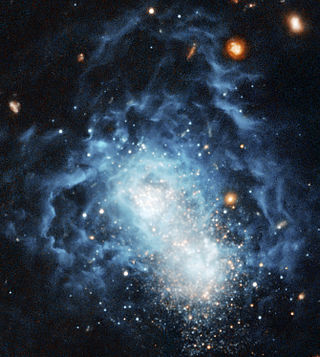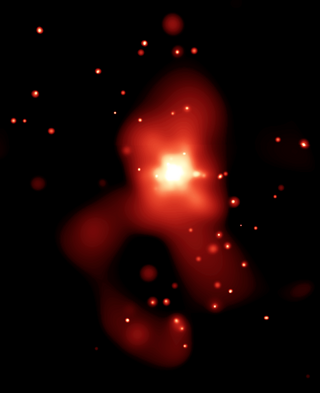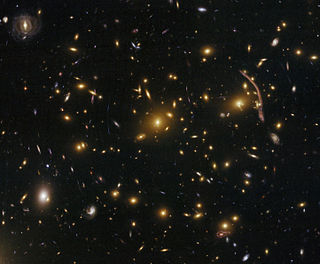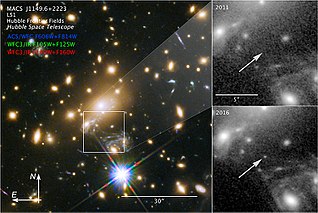Related Research Articles

A galaxy is a system of stars, stellar remnants, interstellar gas, dust, and dark matter bound together by gravity. The word is derived from the Greek galaxias (γαλαξίας), literally 'milky', a reference to the Milky Way galaxy that contains the Solar System. Galaxies, averaging an estimated 100 billion stars, range in size from dwarfs with less than a hundred million stars, to the largest galaxies known – supergiants with one hundred trillion stars, each orbiting its galaxy's center of mass. Most of the mass in a typical galaxy is in the form of dark matter, with only a few percent of that mass visible in the form of stars and nebulae. Supermassive black holes are a common feature at the centres of galaxies.
The following is a timeline of galaxies, clusters of galaxies, and large-scale structure of the universe.

A galaxy cluster, or a cluster of galaxies, is a structure that consists of anywhere from hundreds to thousands of galaxies that are bound together by gravity, with typical masses ranging from 1014 to 1015 solar masses. They are the second-largest known gravitationally bound structures in the universe after some superclusters (of which only one, the Shapley Supercluster, is known to be bound). They were believed to be the largest known structures in the universe until the 1980s, when superclusters were discovered. One of the key features of clusters is the intracluster medium (ICM). The ICM consists of heated gas between the galaxies and has a peak temperature between 2–15 keV that is dependent on the total mass of the cluster. Galaxy clusters should not be confused with galactic clusters (also known as open clusters), which are star clusters within galaxies, or with globular clusters, which typically orbit galaxies. Small aggregates of galaxies are referred to as galaxy groups rather than clusters of galaxies. The galaxy groups and clusters can themselves cluster together to form superclusters.

The Andromeda Galaxy is a barred spiral galaxy and is the nearest major galaxy to the Milky Way. It was originally named the Andromeda Nebula and is cataloged as Messier 31, M31, and NGC 224. Andromeda has a diameter of about 46.56 kiloparsecs and is approximately 765 kpc from Earth. The galaxy's name stems from the area of Earth's sky in which it appears, the constellation of Andromeda, which itself is named after the princess who was the wife of Perseus in Greek mythology.

An elliptical galaxy is a type of galaxy with an approximately ellipsoidal shape and a smooth, nearly featureless image. They are one of the four main classes of galaxy described by Edwin Hubble in his Hubble sequence and 1936 work The Realm of the Nebulae, along with spiral and lenticular galaxies. Elliptical (E) galaxies are, together with lenticular galaxies (S0) with their large-scale disks, and ES galaxies with their intermediate scale disks, a subset of the "early-type" galaxy population.

Spiral galaxies form a class of galaxy originally described by Edwin Hubble in his 1936 work The Realm of the Nebulae and, as such, form part of the Hubble sequence. Most spiral galaxies consist of a flat, rotating disk containing stars, gas and dust, and a central concentration of stars known as the bulge. These are often surrounded by a much fainter halo of stars, many of which reside in globular clusters.

A starburst galaxy is one undergoing an exceptionally high rate of star formation, as compared to the long-term average rate of star formation in the galaxy or the star formation rate observed in most other galaxies. For example, the star formation rate of the Milky Way galaxy is approximately 3 M☉/yr, while starburst galaxies can experience star formation rates of 100 M☉/yr or more. In a starburst galaxy, the rate of star formation is so large that the galaxy consumes all of its gas reservoir, from which the stars are forming, on a timescale much shorter than the age of the galaxy. As such, the starburst nature of a galaxy is a phase, and one that typically occupies a brief period of a galaxy's evolution. The majority of starburst galaxies are in the midst of a merger or close encounter with another galaxy. Starburst galaxies include M82, NGC 4038/NGC 4039, and IC 10.

The Hubble Ultra-Deep Field (HUDF) is a deep-field image of a small region of space in the constellation Fornax, containing an estimated 10,000 galaxies. The original data for the image was collected by the Hubble Space Telescope from September 2003 to January 2004. It includes light from galaxies that existed about 13 billion years ago, some 400 to 800 million years after the Big Bang.

I Zwicky 18 is a blue compact dwarf galaxy located about 59 million light years away in the constellation Ursa Major. The galaxy was first identified by Swiss astronomer Fritz Zwicky in a 1930s photographic survey of galaxies.

Interacting galaxies are galaxies whose gravitational fields result in a disturbance of one another. An example of a minor interaction is a satellite galaxy disturbing the primary galaxy's spiral arms. An example of a major interaction is a galactic collision, which may lead to a galaxy merger.

NGC 4261 is an elliptical galaxy located around 100 million light-years away in the constellation Virgo. It was discovered April 13, 1784, by the German-born astronomer William Herschel. The galaxy is a member of its own somewhat meager galaxy group known as the NGC 4261 group, which is part of the Virgo Cluster.

NGC 1427A is an irregular galaxy in the constellation Fornax. Its distance modulus has been estimated using the globular cluster luminosity function to be 31.01 ± 0.21 which is about 52 Mly. It is the brightest dwarf irregular member of the Fornax cluster and is in the foreground of the cluster's central galaxy NGC 1399.

Abell 370 is a galaxy cluster located nearly 5 billion light-years away from the Earth, in the constellation Cetus. Its core is made up of several hundred galaxies. It was catalogued by George Abell, and is the most distant of the clusters he catalogued.

MACS J0717.5+3745 is a large galaxy cluster located 5.4 billion light years away in the constellation Auriga, appearing in the Massive Cluster Survey (MACS).
GOODS-N-774 also called "Sparky", is a distant early galaxy which is in the process of core formation. The galaxy is massive and extremely compact, forming stars furiously. It is thought to be on its way to becoming a giant elliptical galaxy. This galaxy was discovered in 2014, and is some 11 billion light years distant. In the sky, it is located in the constellation of Ursa Major. It is the first discovered galaxy in this stage of giant galaxy formation.

IDCS J1426.5+3508 is an extremely massive young galaxy cluster. It is the most massive galaxy cluster detected at such an early age.

GN-z11 is a high-redshift galaxy found in the constellation Ursa Major. It is among the farthest known galaxies from Earth ever discovered. The 2015 discovery was published in a 2016 paper headed by Pascal Oesch and Gabriel Brammer. Up until the discovery of JADES-GS-z13-0 in 2022 by the James Webb Space Telescope, GN-z11 was the oldest and most distant known galaxy yet identified in the observable universe, having a spectroscopic redshift of z = 10.957, which corresponds to a proper distance of approximately 32 billion light-years. Data published in 2024 established that the galaxy contains the most distant, and therefore earliest, black hole known in the universe.

MACS J1149 Lensed Star 1, also known as Icarus, is a blue supergiant star observed through a gravitational lens. It is the seventh most distant individual star to have been detected so far, at approximately 14 billion light-years from Earth. Light from the star was emitted 4.4 billion years after the Big Bang. According to co-discoverer Patrick Kelly, the star is at least a hundred times more distant than the next-farthest non-supernova star observed, SDSS J1229+1122, and is the first magnified individual star seen.

The Hubble Legacy Field is an image of a small region of space in the constellation Fornax, containing an estimated 265,000 galaxies. The original release was composed of Hubble Space Telescope data accumulated over a 16-year period. Looking back approximately 13 billion years it has been used to search for galaxies that existed at that time. The image was taken in a section of the sky with a low density of bright stars in the near-field, allowing much better viewing of dimmer, more distant objects. It builds on the data collected for the Hubble Ultra-Deep Field, the Hubble eXtreme Deep Field and the Great Observatories Origins Deep Survey.

A dead disk galaxy is a type of galaxy that is no longer able to form new stars. These galaxies are usually massive yet compact, fast spinning disk shaped galaxies. Most of these galaxies stopped forming new stars billion of years ago when the universe was relatively young in age. These types of galaxies are thought to have been formed by an early phase of intense star birth and evolved into a local elliptical galaxy, like that seen in our modern universe.
References
- ↑ "Hubble Captures Massive Dead Disk Galaxy that Challenges Theories of Galaxy Evolution | Astronomy | hubblesite.org". HubbleSite | hubblesite.org. 21 June 2017. Retrieved 2023-10-03.
- ↑ "Hubble Spots Massive, 'Dead' Disk Galaxy in Early Universe | Astronomy | Sci-News.com". Breaking Science News | Sci-News.com. 23 June 2017. Retrieved 2021-01-25.
- ↑ Toft, Sune; Zabl, Johannes; Richard, Johan; Gallazzi, Anna; Zibetti, Stefano; Prescott, Moire; Grillo, Claudio; Man, Allison W. S.; Lee, Nicholas Y.; Gómez-Guijarro, Carlos; Stockmann, Mikkel; Magdis, Georgios; Steinhardt, Charles L. (2017). "A massive, dead disk galaxy in the early Universe". Nature. 546 (7659): 510–513. arXiv: 1706.07030 . Bibcode:2017Natur.546..510T. doi:10.1038/nature22388. PMC 6485677 . PMID 28640271.